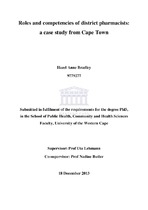| dc.description.abstract | This thesis presents research on the emergence of sub-structure and sub-district pharmacists in Cape Town by considering their roles and related competencies, and the support required to establish them in these new positions. The research was carried out in partnership with Metro District Health Services (MDHS) and City Health. Both organisations provide services across the whole of the Cape Metro. The research took place as MDHS was dividing the Cape Town Metro District into four sub-structures, and the research is embedded in these unfolding developments. The four sub-structures were created to be closer in size to WHO
health districts than the unmanageably large Metro District. Consequently, sub-structures and sub-structure pharmacists in this study should be considered equivalent to districts and district pharmacists in other settings. I used a participatory action research (PAR) approach to partner with pharmacists and
managers in both organisations between 2008 and 2011. The partnership benefitted from the contextual and practice experiences of the health services stakeholders and my evolving research expertise. Including a broad stakeholder group was considered important for developing the shared learning and understanding that would translate into action and changen in the organisations. The flexible and emergent approach of PAR was considered suited to a complex health system in the midst of change. After an initiation stage, the research evolved into a series of five iterative cycles of action and reflection, each providing increasing understanding of the roles and related competencies of sub-structure and sub-district pharmacists, and their experiences as they transitioned into
these new management positions in the two organisations. The research centered around two series of three interactive workshops I facilitated, attended by both pharmacists and managers, in which I contributed information from published literature and documentary reviews to the collaborative processes. Semi-structured interviews and focus groups were conducted at various stages during the research, to inform conceptualization and supplement workshops, and later on, during years three and four, to reflect on the experiences of substructure and sub-district pharmacists. The research identified five main roles each for sub-structure and sub-district pharmacists. Four of these roles are the same for each: Sub-structure (sub-district) management Planning, co-ordination and monitoring of pharmaceuticals, human resources, budget, infrastructure Information and advice Quality assurance and clinical governance But their fifth roles are different: Research, for sub-structure pharmacists. Dispensing at clinics for sub-district pharmacists. But although they look similar, there were substantial differences between sub-structure and sub-district pharmacist roles in the two organisations. Their roles were shaped by the differences in leadership and governance, as well as by the services provided by the two organisations. Sub-structure pharmacists were generally involved in strategic level management functions whilst sub-district pharmacists combined sub-district management activities with dispensing in clinics. Essentially the two cadres were working at different management and leadership levels, with sub-structure pharmacists working at middle management level and sub-district pharmacists straddling first level and middle management levels. Five competency clusters were identified for both cadres, each with several competencies. Professional pharmacy practice Health system/public health Management Leadership Personal, interpersonal and cognitive Whilst professional pharmacy practice competencies were particularly valued by substructure and sub-district managers, overall, sub-structure and sub-district pharmacists required generic management and leadership competencies. Along with the more technical management and leadership competencies, both organisations recognised the importance of viii „softer‟ competencies for pharmacists moving into these management positions. Again, although the competencies appear similar, there were differences between the roles, so that the different cadres required different competencies within these competency clusters. Transitioning into these new management positions was an emergent process, which entailed pharmacists changing form performing technical and clinical functions associated with
professional pharmacy practice to co-ordinating pharmaceutical services across the substructure or sub-district. They moved from working in a pharmacy to being a member of a multi-professional team in a sub-structure or sub-district. Adjusting to these new management positions took time and was facilitated by several personal and organisational factors which varied in the two organisations. Managers and pharmacists mentioned the positive contribution of the PAR in assisting with this transition through the development of shared understanding of the DHS and the roles and functions of pharmacists working in these management positions. The research assisted with practical aspects including the development of new job descriptions. Several implications for developing competencies in sub-structure and sub-district pharmacists emerged during the research. Firstly, although competency frameworks for substructure and sub-district pharmacists are useful for selecting new staff, conducting performance appraisals and identifying learning needs, they need to be tailored for each setting. Secondly, a mixture of traditional training options, including academic qualifications and short courses, as well as innovative on-the-job support such as mentoring and coaching are required to support sub-structure and sub-district pharmacists, and other similar cadres in these positions. | en_US |

